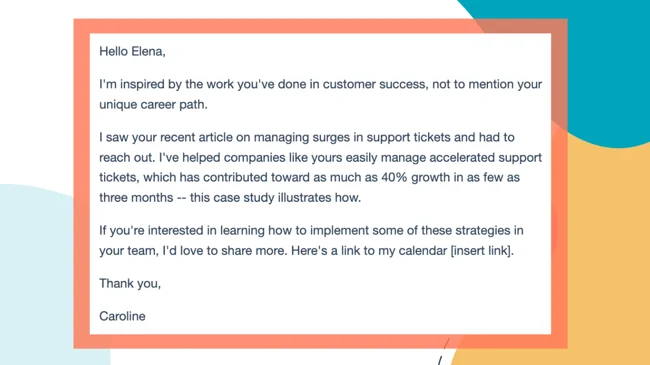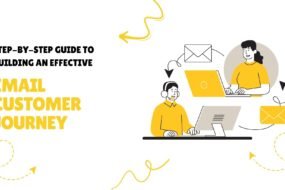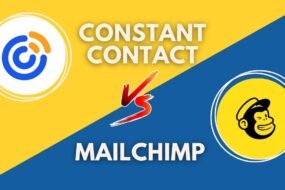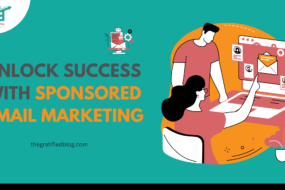
First impressions count – especially for your business. With the ever-increasing amount of messages being sent daily, getting someone’s attention can be difficult. And here’s where introduction emails come into play.
An Introduction email can be the first impression that a company makes on its customers. A lousy introduction email can make customers feel that you are an amateur. On the other hand, a good introduction email can make customers think you are ready to help their business grow.
Now, you might say: Okay, so a well-crafted introduction email can help me convert a lead into a loyal customer. However, how can I craft a perfect introduction email?
Well, we are here with this blog! We’ll answer these questions, discover why introduction emails are so valuable, and learn how to create the best intro emails to boost your sales.
What Are Introduction Emails?
Introduction emails are emails that introduce your company to a person. They are typically sent to individuals who have signed up for you and expressed an interest in your product, service, or business.
If a user joins a site and needs to learn how to use it, they will be less likely to return. Thus, a good introduction email will tell the user how to get the most out of the site.
Hence, these emails are essential for websites that offer many features.
For example, if the site has a forum, the introduction email can tell users about it and how to use it. This will make the user feel special, and hence, it will encourage them to return to your site again and again.

Source: Hubspot.com
Why Are Introduction Emails Important?
An introduction email is an essential form of communication in the business world. It serves as a means to establish initial contact with individuals you have never met before,
Providing them with essential information about who you are and the purpose of your message.
This email cover letter is often utilized when requesting information about a job, seeking advice, or even promoting a product or service.
The opening line of an introduction email plays a pivotal role in grabbing the recipient’s attention and establishing relevance.
Crafting a clear, concise, and informative email is essential to increase the likelihood of receiving a response.
As part of its content, you should include details such as how you obtained the recipient’s email address, your connection or acquaintance with them, and the reasons behind reaching out.
In addition to reaching out to individuals you still need to meet, writing a self-introduction email to your team is equally important.
This act demonstrates your enthusiasm for getting to know your colleagues and showcases your role within the company.
By providing background information about yourself, you help your coworkers understand your professional background and the responsibilities you’re taking on.
This early correspondence with your team establishes a solid foundation for building connections and fostering a positive work environment.
While composing an introductory email, adhering to proper email etiquette and maintaining a professional tone is crucial.
Crafting a self-introduction email that exudes positivity and politeness can significantly contribute to establishing strong connections with new colleagues and clients.
Remember to keep it short, as brevity is critical in capturing the recipient’s attention and conveying your message effectively.

Source: indeed.com
How To Create Great Introduction Emails?
Introduction emails don’t require much time and effort to create and send. These emails are also generally short – often just one or two paragraphs.
You can create one while having coffee. But you’ll still need to keep an eye on specific points to make the most out of it.
On that note, here’s a simple process to create an introduction email that will help you get new subscribers to open your newsletters
1. Strong Subject Line
An essential element for capturing attention is a compelling subject line that recipient’s attention in follow-up emails.
The concise, one-line description of your email serves as your initial and, sometimes, only opportunity to connect with a customer or business contact.
A successful subject line is often personal or descriptive and conveys a sense of urgency. Given that people tend to scan their inboxes, keeping your subject line short and engaging is vital while ensuring it remains relevant to the recipient.
Regarding follow-up email subject lines, you can use personalization, connect with the previous email, ask open-ended questions, suggest a time, or keep it short and catchy.
Remember that the subject line is pivotal in influencing whether the email will be opened or not deleted, so make it count!
2. Limit Sales Pitching
When crafting an introduction email, it’s crucial to prioritize the recipient and their needs.
Instead of immediately promoting your name, take the time to describe yourself and your business in the first few lines, showcasing the value you can offer.
Remember that the subject line is pivotal as it immediately captures the recipient’s attention. To ensure clarity and informativeness, maintain a professional tone throughout the email.
When crafting a brand pitch email template, keeping it short and sweet is essential. Limit your email to two or three paragraphs, and choose a professional subject line that grabs the reader’s interest.
Showing appreciation for the recipient’s work or the company they represent can also highlight their significance.
If you find it helpful, use a formal introduction email template to structure your message and ensure it remains brief and to the point.
Remember to personalize your email to the brand you’re pitching and let your character shine through.
Don’t be afraid to include your unique touch to stand out from the hundreds of emails a marketing manager is likely to receive
3. Personalize Email
An introduction email is a way to communicate with others and introduce yourself, but many people need to write an effective one. Email personalization is the most critical thing to remember,
Which means taking the time to research the customer and genuinely connect with their interests.
This will show the reader that you care about them and help them feel connected to you.
When introducing yourself in an email, use an informative subject line, personalize your greeting, explain why you’re reaching out, and keep it concise.
Initiate with a professional salutation such as “Hello,” “Greetings,” or “Dear,” incorporating the recipient’s full name if formal or their first name if the relationship is more familiar.
Be clear, concise, and always courteous, and proofread your email before sending it. Remember to follow up and schedule your email.
4. Explain Why You Are Reaching Out
When creating introduction emails, it’s crucial to be concise and direct. Begin by mentioning how you acquired the recipient’s contact information and the purpose behind your communication.
Clearly state what you expect from the reader and highlight the value you can offer them. Consider mentioning a mutual connection to establish credibility.
Remember to relate your message to the main point and support your statements with evidence. Incorporate transitional phrases to guarantee seamless transitions from one paragraph to the next.
Lastly, conclude your email with a clear call to action.
Adhering to these guidelines can develop a compelling and concise email that captivates your reader.
5. Adding Engaging CTA
A well-written and well-designed email can be an excellent tool for introducing your business, promoting a product or service, and increasing sales.
But a solid CTA at the end can double the impact. A CTA or Call-to-action always triggers the readers to take the next step.
Hence, always try to keep the CTA relevant to the content of the email, such as introducing yourself or promoting an upcoming event.
Introduction emails are a great way to make a first impression on potential customers, and a clear and concise CTA can encourage them to check out your business and visit your website.
A good CTA can increase conversions and sales, and it should be clear, concise, and visually stunning enough to inspire readers to take the following steps toward becoming a customer.
The CTA should be placed in a prominent position and stand out from the rest of the email. CTA buttons can make it obvious what action you want the reader to take.
The CTA text should be short, while the CTA button should be visible to the reader. Enhance the appeal of your CTA and attract more attention by incorporating images or vector art.
6. Acknowledge & Close
When writing introduction emails, it’s essential to acknowledge and thank your subscribers for taking the time to read your email.
The closing part of the email should leave a positive impression on the recipient, using professional closing words such as “regards” or “sincerely,” followed by your name with your signature or logo.
Incorporate links to your social media channels for supplementary engagement handles. It is recommended to limit the size of the email to three brief paragraphs.
Initiate your email with a sincere expression of gratitude, conveying heartfelt thanks in the opening for what the recipient did for you to be thankful for.
In the case of a formal email, use a professional email signature detailing your complete name, job title, and affiliated company.
When crafting an informal thank-you email, utilize your first name. Add appreciation to the closing statement, such as a grateful closing or quick compliment.
Make it clear to your recipient that you appreciate their time and effort.
7. Proofread At Least Thrice
When it comes to introduction emails, proofreading is essential. It shows that you care about the person on the other end of your email and your business.
It demonstrates that you have taken the time to ensure that your email is perfect before sending it. To ensure your email is encouraging, share it with your friends and ask for feedback.
It is hard to edit or proofread a paper you have just finished writing, so it is better to put it aside for a few hours, days, or weeks.
This will give you a fresh look at the paper and help you see what is on the page. It is worth paying attention to the details that allow you to make a good impression.
Re-read messages before you send them, and check your grammar, spelling, capitalization, and punctuation. Use spelling and grammar-checking tools if your email program supports it.
Consider reading your message aloud to help identify any errors or awkward phrasing you might otherwise miss. And remember to keep it short!
8. Keep It Concise
Crafting a brief and to-the-point introduction email is essential to increase the chances of being read and understood.
People are generally busy and may need more time to read lengthy emails, so it’s best to stick to critical information and avoid unnecessary details or lengthy explanations.
A good subject line is also crucial, as The subject should communicate the primary message or the key takeaway you want the reader to grasp.
It’s recommended to keep the subject line between 1-3 words long and clear and concise.
According to a recent study, incorporating the recipient’s name in subject lines boosted the likelihood of the email being opened by nearly 50%.
It’s also essential to provide context and briefly state the purpose of writing at the beginning of the message.
Following these guidelines increases your chances of getting a quick response and making meaningful connections.
A clear and concise subject line for introduction emails is crucial to grab the recipient’s attention.
For example, “Introduction: [Your Name]” or “Intro: [Your Name] and [Purpose of Email]” can work well.
9. Highlight Mutual Connections Or Shared Interests
When writing introduction emails, making an excellent first impression is essential. One way to do this is by mentioning any mutual connections or shared interests with the recipient.
This can create a sense of familiarity and make the email more engaging. It also establishes a common ground for further conversation.
Before reaching out to someone in an email, assess whether you have any shared connections with the recipient.
If you know someone working for the same company or who has studied at the same educational institution, ask if they could assist in making an introduction or allow you to reference their name in your email.
This can enhance credibility and improve the chances of your email being well-received.
Writing a compelling subject line and making the first line about the recipient are also essential Guidelines for eliciting a response to an introductory email.
Remember that an introduction email is often the first point of contact with a prospective client, collaborator, or business partner, so it’s essential to make it short and sweet.
10. Provide Value Or Offer Assistance
When writing an introduction email, offering something of value or assistance to the recipient is essential instead of solely focusing on what you want or need from them.
This could be sharing a helpful resource, offering advice or support, or suggesting a potential collaboration.
By providing value upfront, you can make your introduction email more compelling and increase the likelihood of a positive response.
Personalizing your email and making it easy for the recipient to take the necessary steps is also important.
Additionally, you should remain firm on your price while helping the customer understand the value and offering valuable options.
When writing cold emails, adding value and showing that you want to help the prospect achieve their goals is essential.
You can do this by showing that you understand and can address their pain points, thanking them for reading your email, and offering insight into what your product or service can help them with.
Finally, research has shown that offering incentives and personalizing survey invites can increase response rates.
How Do You Introduce Someone In An Email Example?
When introducing someone in an email, keeping the subject line short and informative is essential. Start with a greeting and add an opening sentence.
Introduce both parties and tell them why they should meet. Be brief and to the point, but provide accurate context for the intro.
Request the individual seeking the connection to compose a brief blurb on why the recipient should meet them.
Once you have it, copy and paste it into the email, including your endorsement, and you’re ready to proceed. Make the intent of your email clear by stating it in the subject line.
The best way to do it is to start with “Introduction:” or “Intro:”. It’s self-explanatory and catches the eye quickly
Why Are Introduction Emails Important?
Conclusion
Introduction emails are a great way to break the ice with potential clients and establish relationships.
Hence, just like you dress up to meet your client for the first time, you’ll need to craft your email the same way to create an excellent first impression.
Just use the above points, keep your email engaging, and let them know what values you can provide, and that’s it.
Furthermore, if you have any issues regarding the above points, we would love to solve them in the comment section below!
Also read: A complete Guide To Opt-In Email Marketing, and
How To Create A B2B Email Marketing Strategy








No Comments